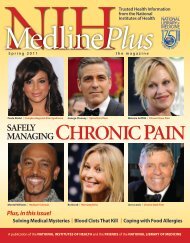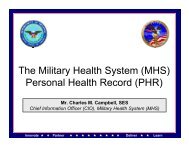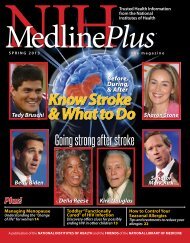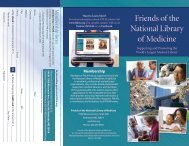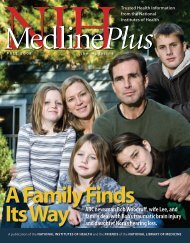Sam Donaldson's cancer survival tips - National Library of Medicine ...
Sam Donaldson's cancer survival tips - National Library of Medicine ...
Sam Donaldson's cancer survival tips - National Library of Medicine ...
You also want an ePaper? Increase the reach of your titles
YUMPU automatically turns print PDFs into web optimized ePapers that Google loves.
Pr<strong>of</strong>iles by Clinical Center Communications, NIH Clinical Center<br />
The NIH Clinical Center: For more than 50 years, the Center’s physicians<br />
and scientists have been translating laboratory discoveries into better treatments,<br />
therapies and interventions to improve the nation’s health. Presented here are three<br />
patients whose lives have been changed for the better at the Clinical Center.<br />
Annie Brown <strong>of</strong> Washington, DC, has experienced recurrent<br />
pain crises associated with sickle cell disease since childhood. It’s a chronic and <strong>of</strong>ten<br />
fatal form <strong>of</strong> anemia. In the United States, this inherited disease mainly strikes African<br />
Americans. Red blood cells typically are round and smooth. They move easily through<br />
blood vessels carrying oxygen to all parts <strong>of</strong> the body. In sickle cell anemia, the cells are<br />
shaped like a sickle—or crescent. Hard and sticky, these cells tend to get stuck in the<br />
vessels. When blood flow is blocked, the result is pain. What brought Annie to the Clinical<br />
Center was one <strong>of</strong> the disease’s secondary effects: pulmonary hypertension, or high<br />
blood pressure in the arteries that supply the lungs. “I used to not be able to walk down<br />
steps without stopping,” says Annie. “I couldn’t do anything.” Her study team is giving<br />
her blood exchange transfusions, inhalants such as oxygen and nitric oxide, and using<br />
vasodilators that open the blood vessels <strong>of</strong> the arteries. She’s doing far better than her<br />
childhood doctors predicted. They told her parents that Annie “wouldn’t live past age<br />
18 and that she would never have children.” Now 56, Annie has exceeded the median<br />
life expectancy for people with the disease (42 for men and 48 for women) and has two<br />
grown children.<br />
Clenton G. Winford, a Texan, was 25 years old<br />
when he first came to the Clinical Center in 1988. Doctors there had just begun to<br />
study families diagnosed with von Hippel-Lindau (VHL). Clenton, whose father<br />
was diagnosed the year Clenton was born, volunteered for an observational study<br />
to help doctors learn what they could by monitoring the progress <strong>of</strong> the disease<br />
in those who have it. The disorder caused retinal tumors, which had resulted<br />
in Clenton’s blindness. “I was dreadfully ill and had no idea what I should do,”<br />
Clenton recalls. “I came here purely for research and was diagnosed, but then was<br />
<strong>of</strong>fered treatment.” As a volunteer patient in a series <strong>of</strong> research studies, he has<br />
had surgical removal <strong>of</strong> tumors and cysts from his brain, spinal cord, pancreas,<br />
adrenal gland, and end lymphatic sac. He also has had countless sessions <strong>of</strong><br />
imaging scans and other tests to chart the progression <strong>of</strong> his disease. “Those <strong>of</strong><br />
us who have been dismissed elsewhere and have been told there is nothing else<br />
to be done, find that by coming here, we have one more chance to look at our<br />
problems, maybe another roll <strong>of</strong> the dice — another turn at bat, if you will.” Over<br />
the years, doctors involved in his care, with the help <strong>of</strong> volunteer patients with the<br />
disorder, have identified three different <strong>cancer</strong> genes and discovered two new diseases<br />
(Hereditary Papillary Renal Carcinoma and Familial Renal Oncocytoma),<br />
benefiting thousands <strong>of</strong> patients worldwide.<br />
www.medlineplus.gov Spring 2007 23



